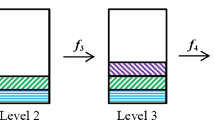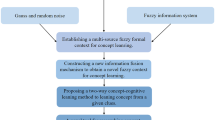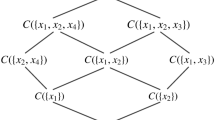Abstract
Recently, formal concept analysis has become a potential direction of cognitive computing, which can describe the processes of cognitive concept learning. We establish a concept hierarchy structure based on the existing cognitive concept learning methods. However, none of these methods could obtain the following results: get the concept, recognize objects and distinguish between two different objects. In this paper, our focus is to construct an attribute-oriented multi-level cognitive concept learning method so as to improve and enhance the ability of cognitive concept learning. Firstly, the view point of human cognition is discussed from the multi-level approach, and then the mechanism of attribute-oriented cognitive concept learning is investigated. Through some defined special attributes, we propose a corresponding structure of attribute-oriented multi-level cognitive concept learning from an interdisciplinary viewpoint. It is a combination of philosophy and psychology of human cognition. Moreover, to make the presented attribute-oriented multi-level method easier to understand and apply in practice, an algorithm of cognitive concept learning is established. Furthermore, a case study about how to recognize the real-world animals is studied to use the proposed method and theory. Finally, in order to solve conceptual cognition problems, we perform an experimental evaluation on five data sets downloaded from the University of California-Irvine (UCI) databases. And then we provide a comparative analysis with the existing \(granular\ computing\ approach\ to\ two\)-\(way\ learning\) [44] and the three-\(way\ cognitive\ concept\ learning\ via\ multi\)-granularity [9]. We obtain more number of concepts than \(the\ two\)-\(way\ learning\ and\ the\ three\)-\(way\ cognitive\ concept\ learning\ approaches\), which shows the feasibility and effectiveness of our attribute-oriented multi-level cognitive learning method.





Similar content being viewed by others
Explore related subjects
Discover the latest articles, news and stories from top researchers in related subjects.References
Agarwal GC (1991) Human cognition is an adaptive process. Behav Brain Sci 14(3):485–486
Bargiela A, Pedrycz W (2006) The roots of granular computing. In: IEEE international conference on granular computing, pp 806–809
Belohlávek R, Baets BD, Outrata J, Vychodil V (2009) Inducing decision trees via concept lattices. In: International conference on concept lattices and their applications, Cla 2007, Montpellier, France, October, DBLP, pp 455–467
Düntsch I, Gediga G (2002) Modal-style operators in qualitative data analysis. In: IEEE international conference on data mining, 2002, ICDM 2003, pp 155–162
Ganter B (1999) Formal concept analysis: mathematical foundations. Springer, New York
Huang C, Li J, Mei C, Wu WZ (2017) Three-way concept learning based on cognitive operators: an information fusion viewpoint. Int J Approx Reason 83:218–242
Konecny J (2017) On attribute reduction in concept lattices: methods based on discernibility matrix are outperformed by basic clarification and reduction. Inf Sci 415–416:199–212
Kumar CA, Ishwarya MS, Loo CK (2015) Formal concept analysis approach to cognitive functionalities of bidirectional associative memory. Biol Inspir Cogn Archit 12:20–33
Li J, Huang C, Qi J, Qian Y, Liu W (2017) Three-way cognitive concept learning via multi-granularity. Inf Sci 378:244–263
Li J, Mei C, Lv Y (2012) Knowledge reduction in real decision formal contexts. Inf Sci 189:191–207
Li J, Mei C, Lv Y (2013) Incomplete decision contexts: approximate concept construction, rule acquisition and knowledge reduction. Int J Approx Reason 54(1):149–165
Li J, Mei C, Xu W, Qian Y (2015) Concept learning via granular computing: a cognitive viewpoint. Inf Sci 298:447–467
Li J, Ren Y, Mei C, Qian Y, Yang X (2016) A comparative study of multigranulation rough sets and concept lattices via rule acquisition. Knowl Based Syst 91:152–164
Li W, Pedrycz W, Xue X, Xu W, Fan B (2018) Distance-based double-quantitative rough fuzzy sets with logic operations. Int J Approx Reason 101:206–233
Liu M, Shao M, Zhang W, Wu C (2007) Reduction method for concept lattices based on rough set theory and its application. Comput Math Appl 53(9):1390–1410
Luksch P, Wille R (1991) A mathematical model for conceptual knowledge systems. Classification, data analysis, and knowledge organization. Springer, Berlin, pp 156–162
Modha DS, Ananthanarayanan R, Esser SK, Ndirango A, Sherbondy AJ, Singh R (2011) Cognitive computing. Commun ACM 54(8):62–71
Moreton E, Pater J, Pertsova K (2017) Phonological concept learning. Cogn Sci 41(1):4–69
Pedrycz W, Skowron A, Kreinovich V (2008) Handbook of granular computing. Wiley-Interscience, Hoboken
Pei D, Mi JS (2011) Attribute reduction in decision formal context based on homomorphism. Int J Mach Learn Cybern 2(4):289–293
Pinggera J (2015) Visualizing human behavior and cognition: the case of process modeling. In: International conference on business process management, Springer, Cham, pp 547–551
Qi J, Wei L, Yao Y (2014) Three-way formal concept analysis. In: International conference on rough sets and knowledge technology, Springer, Cham, pp 732–741
Qi J, Qian T, Wei L (2016) The connections between three-way and classical concept lattices. Knowl Based Syst 91:143–151
Rodríguez-Jiménez JM, Cordero P, Enciso M, Mora A (2014) A generalized framework to consider positive and negative attributes in formal concept analysis. In: Bertet K, Rudolph S (eds) Proceedings of the eleventh international conference on concept lattices and their applications, CLA 2014. Pavol Jozef Šafárik University in Košice, Slovakia, pp 267–279
Rodríguez-Jiménez JM, Cordero P, Enciso M, Rudolph S (2016) Concept lattices with negative information: a characterization theorem. Inf Sci 369:51–62
Shao M, Yang H (2013) Two kinds of multi-level formal concepts and its application for sets approximations. Int J Mach Learn Cybern 4(6):621–630
Shivhare R, Cherukuri AK (2017) Three-way conceptual approach for cognitive memory functionalities. Int J Mach Learn Cybern 8(1):21–34
Shivhare R, Cherukuri AK, Li J (2017) Establishment of cognitive relations based on cognitive informatics. Cogn Comput 9(5):721–729
Singh PK, Cherukuri AK, Li J (2017) Concepts reduction in formal concept analysis with fuzzy setting using Shannon entropy. Int J Mach Learn Cybern 8(1):179–189
Vormbrock B (2005) Complete subalgebras of semiconcept algebras and protoconcept algebras. In: International conference on formal concept analysis, Berlin, Heidelberg, pp 329–343
Wang H, Zhang WX (2008) Approaches to knowledge reduction in generalized consistent decision formal context. Math Comput Model 48(11–12):1677–1684
Wang R, Wang XZ, Kwong S, Xu C (2017) Incorporating diversity and informativeness in multiple-instance active learning. IEEEE Trans Fuzzy Syst 25(6):1460–1475
Wang XZ, Wang R, Xu C (2018) Discovering the relationship between generalization and uncertainty by incorporating complexity of classification. IEEE Trans Cybern 48(2):703–715
Wang XZ, He YL, Wang DD (2014) Non-naive Bayesian classifiers for classification problems with continuous attributes. IEEE Trans Cybern 44(1):21–39
Wang XZ, Wang R, Feng HM, Wang HC (2014) A new approach to classifier fusion based on upper integral. IEEE Trans Cybern 44(5):620–635
Wang X, Xing HJ, Li Y, Hua Q, Dong CR, Pedrycz W (2015) A study on relationship between generalization abilities and fuzziness of base classifiers in ensemble learning. IEEE Trans Fuzzy Syst 23(5):1638–1654
Wang Y (2008) On concept algebra: a denotational mathematical structure for knowledge and software modeling. Int J Cogn Inform Nat Intell 2(2):1–19
Wang Y (2009) On cognitive computing. Int J Softw Sci Comput Intell 1(3):1–15
Wang Y, Chiew V (2010) On the cognitive process of human problem solving. Cogn Syst Res 11(1):81–92
Wang Y, Zadeh LA, Yao Y (2012) On the system algebra foundations for granular computing. In: Software and intelligent sciences: new transdisciplinary findings, \(|G|\) Global, pp 98–121
Wille R (1992) Concept lattices and conceptual knowledge systems. Comput Math Appl 23(6–9):493–515
Wille R (1982) Restructuring lattice theory: an approach based on hierarchies of concepts. Ordered sets. Springer, Dordrecht, pp 445–470
Wu WZ, Leung Y, Mi JS (2009) Granular computing and knowledge reduction in formal contexts. IEEE Trans Knowl Data Eng 21(10):1461–1474
Xu W, Li W (2016) Granular computing approach to two-way learning based on formal concept analysis in fuzzy datasets. IEEE Trans Cybern 46(2):366–379
Xu W, Pang J, Luo S (2014) A novel cognitive system model and approach to transformation of information granules. Int J Approx Reason 55(3):853–866
Yao Y (2004) A comparative study of formal concept analysis and rough set theory in data analysis. In: International conference on rough sets and current trends in computing, Springer, Berlin, Heidelberg, pp 59–68
Yao Y (2017) Interval sets and three-way concept analysis in incomplete contexts. Int J Mach Learn Cybern 8(1):3–20
Yao Y (2009) Interpreting concept learning in cognitive informatics and granular computing. IEEE Trans Syst Man Cybern Part B (Cybern) 39(4):855–866
Yao YY (2004) Concept lattices in rough set theory. Fuzzy Information, 2004, Processing NAFIPS’04. In: IEEE annual meeting of the IEEE, vol 2, pp 796–801
Yao YY (2001) On modeling data mining with granular computing. In: Computer software and applications conference, COMPSAC, 2001 25th annual international. IEEE, pp 638–643
Zhao Y, Li J, Liu W, Xu W (2017) Cognitive concept learning from incomplete information. Int J Mach Learn Cybern 8(1):159–170
Acknowledgements
This work is supported by the Macau Science and Technology Development Fund (No. 081/2015/A3), the National Natural Science Foundation of China (No. 71471060, No. 61472463, and No. 61772002), the Science and Technology Research Program of Chongqing Municipal Education Commission (Grant No. KJ1709221).
Author information
Authors and Affiliations
Corresponding author
Additional information
Publisher's Note
Springer Nature remains neutral with regard to jurisdictional claims in published maps and institutional affiliations.
Rights and permissions
About this article
Cite this article
Fan, B., Tsang, E.C.C., Xu, W. et al. Attribute-oriented cognitive concept learning strategy: a multi-level method. Int. J. Mach. Learn. & Cyber. 10, 2421–2437 (2019). https://doi.org/10.1007/s13042-018-0879-5
Received:
Accepted:
Published:
Issue Date:
DOI: https://doi.org/10.1007/s13042-018-0879-5




